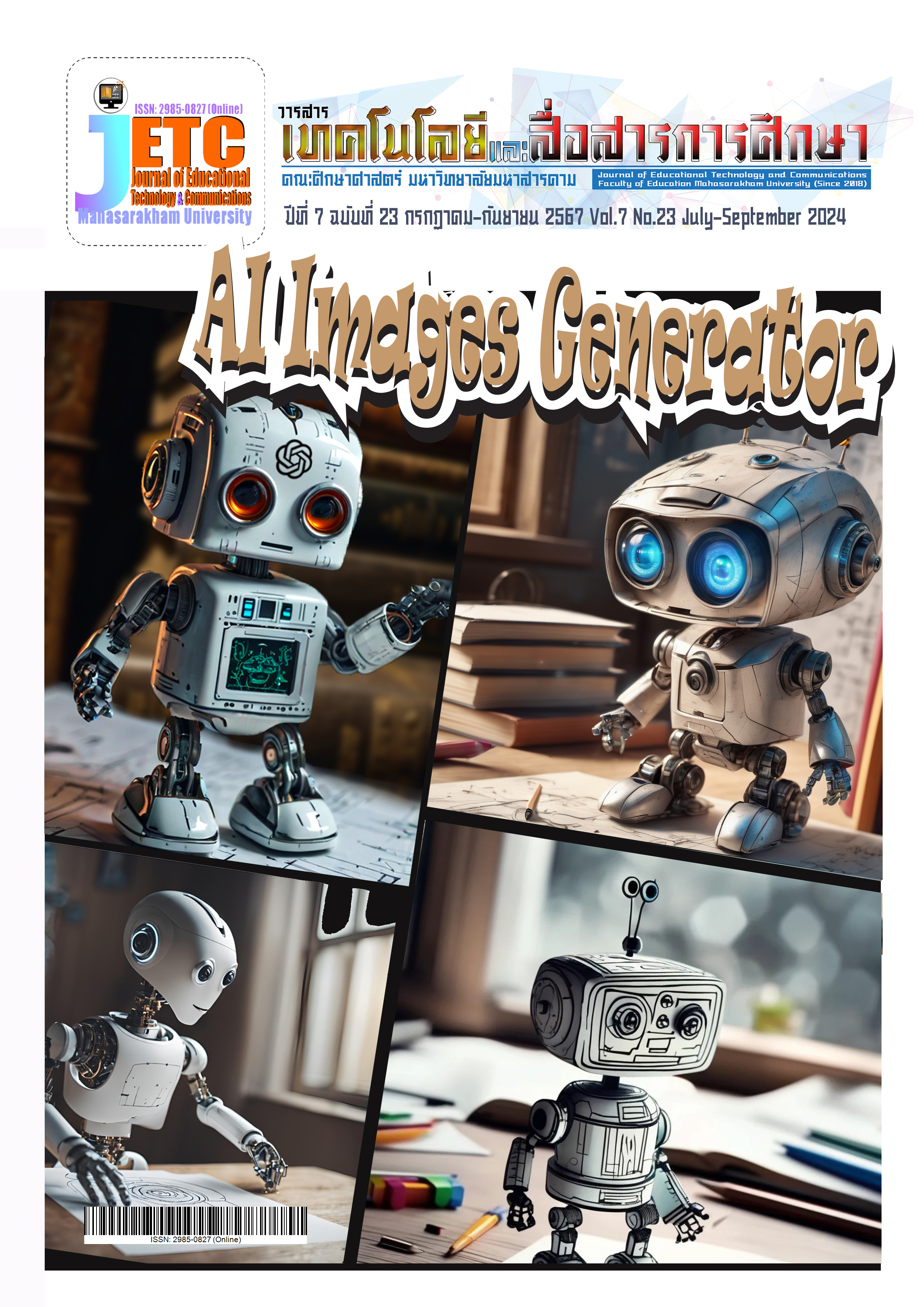เครื่องมือประเมินผลระหว่างเรียนเชิงดิจิทัล: การประยุกต์ใช้เพื่อพัฒนาการเรียนรู้ของผู้เรียน
Main Article Content
บทคัดย่อ
การประเมินผลระหว่างเรียนเชิงดิจิทัลมีบทบาทสำคัญในด้านการศึกษา เพราะช่วยให้ข้อมูลย้อนกลับ แบบทันทีทันใด การติดตามความก้าวหน้าของผู้เรียน และส่งเสริมประสบการณ์การเรียนรู้เฉพาะบุคคล เครื่องมือสำหรับ การประเมินผลระหว่างเรียนเชิงดิจิทัลได้รับความนิยมมากขึ้นในการศึกษายุคใหม่ บทความนี้ได้ศึกษาหลักการของ การประเมินผลระหว่างเรียนและการประเมินระหว่างเรียนเชิงดิจิทัล ซึ่งครอบคลุมถึงสภาพแวดล้อมการเรียนรู้ดิจิทัล การเรียนรู้และการประเมินที่เน้นผู้เรียนเป็นศูนย์กลาง และการเรียนรู้และการประเมินแบบร่วมมือกันของนักเรียน นอกจากนี้ ยังแบ่งประเภทของการประเมินผลระหว่างเรียนเชิงดิจิทัลและยกตัวอย่างการประยุกต์ใช้เครื่องมือการประเมินผลระหว่างเรียนเชิงดิจิทัล เช่น การใช้ Entry และ Exit Slips การทำแบบทดสอบ การใช้แบบสำรวจ การทำแบบฝึกหัด การประเมินย้อนกลับจากเพื่อน และการสะท้อนคิด รวมทั้งให้คำแนะนำในการประยุกต์ใช้เครื่องมือการประเมินระหว่างเรียนเชิงดิจิทัลในการจัดการเรียนการสอน ซึ่งช่วยส่งเสริมการเรียนรู้เชิงรุก การมีส่วนร่วมของนักเรียน และสร้าง สภาพแวดล้อมการเรียนรู้ที่สนับสนุนนักเรียน
Downloads
Article Details
เอกสารอ้างอิง
Black, P., & Wiliam, D. (2009). Developing the theory of formative assessment. Educational Assessment,Evaluation and Accountability, 21(1), 5–31. https://doi.org/10.1007/s11092-008-9068-5
Black, P., & Wiliam, D. (2010). Inside the black box: Raising standards through classroom assessment. Phi Delta Kappan, 92(1), 81–90. https://doi.org/10.1177/003172171009200119
Black, P., & Wiliam, D. (2018). Classroom assessment and pedagogy. Assessment in Education, 25(3). https://doi.org/10.1080/0969594X.2018.1441807
Çekiç, A., & Bakla, A. (2021). A review of digital formative assessment tools: Features and future directions. International Online Journal of Education and Teaching (IOJET), 8(3), 1459–1485. https://eric.ed.gov/?id=EJ1308016
Chen, L.-L., & Chen, C.-M. (2023). Formative e-assessment design in online learning environment International Journal of Education, 15(1), 36. https://doi.org/10.5296/ije.v15i1.20580
Clark, I. (2012). Formative assessment: Assessment is for self-regulated learning. Educational Psychology Review, 24(2), 205–249. https://doi.org/10.1007/s10648-011-9191-6
Faber, J. M., Luyten, H., & Visscher, A. J. (2017). The effects of a digital formative assessment tool on mathematics achievement and student motivation: Results of a randomized experiment. Computers and Education, 106, 83–96. https://doi.org/10.1016/j.compedu.2016.12.001
Gikandi, J. W., Morrow, D., & Davis, N. E. (2011). Online formative assessment in higher education: A review of the literature. Computers and Education, 57(4), 2333–2351. https://doi.org/10.1016/j.compedu.2011.06.004
Hattie, J., & Timperley, H. (2007). The power of feedback. Review of Educational Research, 77(1), 81–112. https://doi.org/10.3102/003465430298487
Kaya-Capocci, S., O’Leary, M., & Costello, E. (2022). Towards a framework to support the implementation of digital formative assessment in higher education. Education Sciences,12(11). https://doi.org/10.3390/educsci12110823
Looney, J. (2012). Formative assessment and improving learning. In N. M. Seel (Ed.), Encyclopedia of the Sciences of Learning. Boston, MA: Springer (1318–1320). Springer US.
Molin, F., Haelermans, C., Cabus, S., & Groot, W. (2020). The effect of feedback on metacognition– A randomized experiment using polling technology. Computers and Education, 152. https://doi.org/10.1016/j.compedu.2020.103885
Mortensen, C. J., & Nicholson, A. M. (2015). The flipped classroom stimulates greater learning and is a modern 21st century approach to teaching today’s undergraduates. Journal of Animal Science, 93(7), 3722–3731.
Nadeem, N., & Falig, H. A. (2020). Kahoot! Quizzes: A formative assessment tool to promote students’ self-regulated learning skills. Journal of Applied Linguistics and Language Research, 7(4), 1–20. https://www.jallr.com/index.php/JALLR/article/view/1117
National Research Council. (2001). Knowing what students know: The science and design of educational assessment. Washington DC: The National Academy Press.
Nicol, D., & MacFarlane-Dick, D. (2006). Formative assessment and self-regulated learning: A model and seven principles of good feedback practice. Studies in Higher Education, 31(2), 199–218. https://doi.org/10.1080/03075070600572090
OECD. (2005). Formative assessment: Improving learning in secondary classrooms. OECD Publishing. https://www.oecd.org/education/ceri/35661078.pdf
Sadler, D. R. (1989). Formative assessment and the design of instructional systems. Instructional Science, 18, 119-144.
https://link.springer.com/article/10.1007/BF00117714
Sullivan, P., McBrayer, J. S., Miller, S., & Fallon, K. (2021). An examination of the use of computer-based formative assessments. Computers and Education, 173. https://doi.org/10.1016/j.compedu.2021.104274
TEAL Center. (2008). Assessment for learning: Formative assessment.
Wiliam, D., & Thompson, M. (2008). Integrating assessment with learning: What will it take to make it work? In C. A. Dwyer (Ed.), The future of assessment. Routledge.
Xuan, Q., Cheung, A., & Sun, D. (2022). The effectiveness of formative assessment for enhancing reading achievement in K-12 classrooms: A meta-analysis. Frontiers in Psychology, 13. https://doi.org/10.3389/fpsyg.2022.990196
Zhyhadlo, O. Y. (2022). Application of digital game-based tools for formative assessment at foreign language lessons. Information Technologies and Learning Tools, 87(1), 139–150. https://doi.org/10.33407/itlt.v87i1.4703


